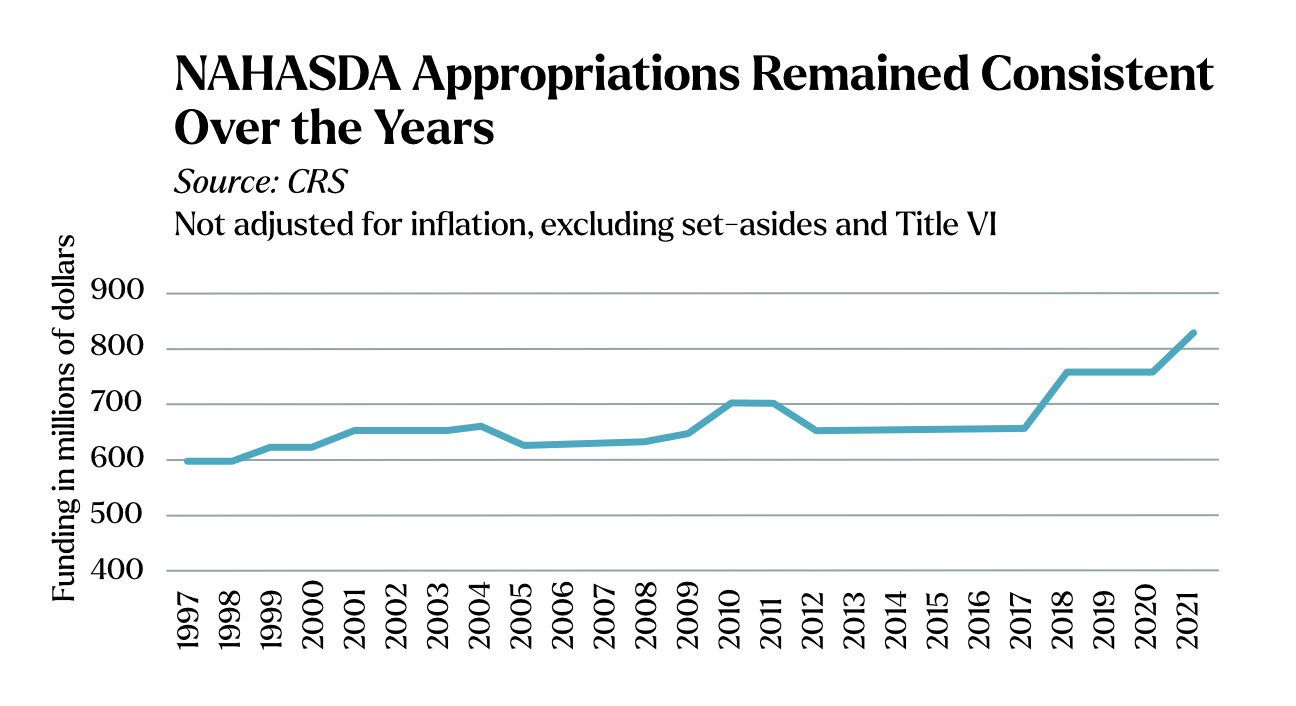 Housing in Indian Country
Housing in Indian Country
more coming soon…
Where to Start
Part 2
The Challenge of Rehab & Renovation
Part 3
Approaching the Middle- & Over-Income Problem
Part 4
The Importance of Housing to Economies & Individuals
This series of articles is going to explore key issues in Indian Country housing and propose actionable approaches to solving these issues for Tribal Leaders. This article, Where to Start, is an introduction to the key issues and provides a starting point for Tribes that feel stuck in their housing situation.
Key Housing Issues Facing Tribal Leaders
Across our work in Indian Country, the biggest need that we hear our Tribal Partners discuss is housing. Whether it’s abandoned or dilapidated homes, waitlists outgrowing the development of affordable houses, overcrowding, the missing solution for middle- and over-income housing, or the changing preferences of the next generation, nearly every Tribe in the Country has a need in housing.
%
Percentage of Overcrowded Households in Tribal Communities
%
Percentage of Overcrowded Households in General Population
This need for housing is not easy to address. Funding Tribal housing may be the most complex and challenging issue than any other in Indian Country. The main source of federal dollars for Tribal housing is the Housing & Urban Development Department (HUD). The 1996 Native American Housing Assistance and Self-Determination Act (NAHASDA) Act defined the structure of HUD’s Tribal housing funding in place today. Under NAHASDA, Tribe’s are granted self-determination powers through annual block grants. Despite the notion of self-determination, NAHASDA funds have never been allocated at the level needed for Tribes to build capacity or meet needs. In fact, NAHASDA funding appropriations have been at nearly the same level since 1996.
“Funding Tribal housing may be the most complex and challenging issue than any other in Indian Country.“
The incredible need and lack of funding has left Tribal Leaders, housing departments, and housing entities at an impasse. Due to minimal funding, Tribes are often unable to build the capacity of housing departments to access other more complex and potentially significant funding instruments available to Tribes. Without the ability to increase capacity, the already significant need grows even more, and the gap in funding to meet the need along with it. To make things even more troublesome, housing is a highly political issue, making it more challenging to administer the limited resources Tribes do have available.
Approaching the Housing Problem
Despite the challenges surrounding developing housing for Tribes, it is possible to find solutions that work for your community. The following Tribal housing strategy key points can give your Tribe a starting point when deciding how you will approach the issue moving forward.
1. Know Your Needs
Every Tribe has some level of need for housing, and most know they have a significant need for housing. But just knowing that there is a need isn’t enough. You have to know what that need is. Being able to specifically explain your housing needs through reliable data points is essential to getting grants and funding, alignment among the government and Tribal community, and for developing your strategy to meet the needs.
Knowledge is powerful. Community needs assessments can discover the details of your community’s housing needs, project housing needs in the future, determine preferences for housing types, and whether housing is a priority in the community. In the past, housing needs assessments were very specific. As the pandemic showed, however, housing intersects with healthcare, economic development, education, and overall community wellbeing. Approaching your data gathering and knowledge creation initiatives from multiple perspectives can be invaluable for the actions you take to meet the needs of the people.
2. Don’t Chase Funds: Direct Goals & Objectives to Needs
As I discussed in Grants 101: Assessing & Winning Funding, it is important for Tribes to allow their goals, objectives, and needs direct funding efforts rather than chasing funding sources without a strategy. This same idea applies in housing. Before seeking or expending any funds on housing—whether its rehabilitation, acquisition, construction, or anything else—it is important to lay out the long-term strategy.
The most effective housing strategies, both in terms of value of implementation and usefulness of the strategy itself, are directed towards the findings of a needs assessment. Funding agencies in particular value the fact that a project is directed specifically to detailed and well-founded data.
Example Housing Goals: With & Without Need
3. Consider All Funding Sources
Major housing developments are almost always made up of a patchwork of funding sources. While HUD is the main source of funding for developments, many other housing agencies and funding instruments exist for Tribes. It is important to consider all of these sources when funding when planning a housing strategy or development. Below is a list of some of the federal agencies that have programs that support housing in some form, but there are also state and private funding sources that can be considered as well.
- U.S. Department of Agriculture
- Economic Development Agency
- Department of Defense
- Bureau of Indian Affairs
- Health & Human Services
- Department of Labor
- Department of Treasury
- Department of Energy
4. Be Creative & Think Sustainable
The most challenging problems require creative solutions. As Tribal Leaders or professionals in the Tribal housing space, it is important to think outside the box and be open to new ideas. The reality of housing in Indian Country is that no one has yet found the perfect solution to the challenges. While this is an incredible challenge and disparity for Tribes across the country, it is also an opportunity to make a big impact for the health and resilience of Tribal communities.
It’s also important to note that as housing projects are developed and needs are met, there is a significant opportunity for Tribes and Tribal housing to be at the forefront of discovering sustainable solutions to housing. Tying projects in with green energy or tax credits through the Infrastructure Bill and Inflation Reduction Act can be an opportunity to make a project both more financially feasible, as well as sustainable for multiple generations that will live in the homes.
Conclusion
Tribal housing is a complex and significant issue that often leaves Tribal Leaders and professionals feeling stuck. However, there is a path forward, and though it requires a significant amount of time and energy, every house that is built represents a huge impact to the lives of an individual, family, and the next generations.

